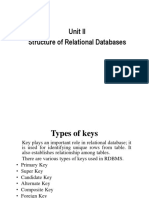0% found this document useful (0 votes)
234 views8 pagesSQL Database Constraints & Keys
SQL constraints are rules for data in tables that ensure accuracy and reliability. Constraints like NOT NULL, UNIQUE, PRIMARY KEY, FOREIGN KEY, CHECK, and DEFAULT specify conditions for columns. If data violates a constraint, the action is aborted to maintain referential integrity between tables.
Uploaded by
Heman SetiaCopyright
© © All Rights Reserved
We take content rights seriously. If you suspect this is your content, claim it here.
Available Formats
Download as DOCX, PDF, TXT or read online on Scribd
0% found this document useful (0 votes)
234 views8 pagesSQL Database Constraints & Keys
SQL constraints are rules for data in tables that ensure accuracy and reliability. Constraints like NOT NULL, UNIQUE, PRIMARY KEY, FOREIGN KEY, CHECK, and DEFAULT specify conditions for columns. If data violates a constraint, the action is aborted to maintain referential integrity between tables.
Uploaded by
Heman SetiaCopyright
© © All Rights Reserved
We take content rights seriously. If you suspect this is your content, claim it here.
Available Formats
Download as DOCX, PDF, TXT or read online on Scribd
/ 8






































































































